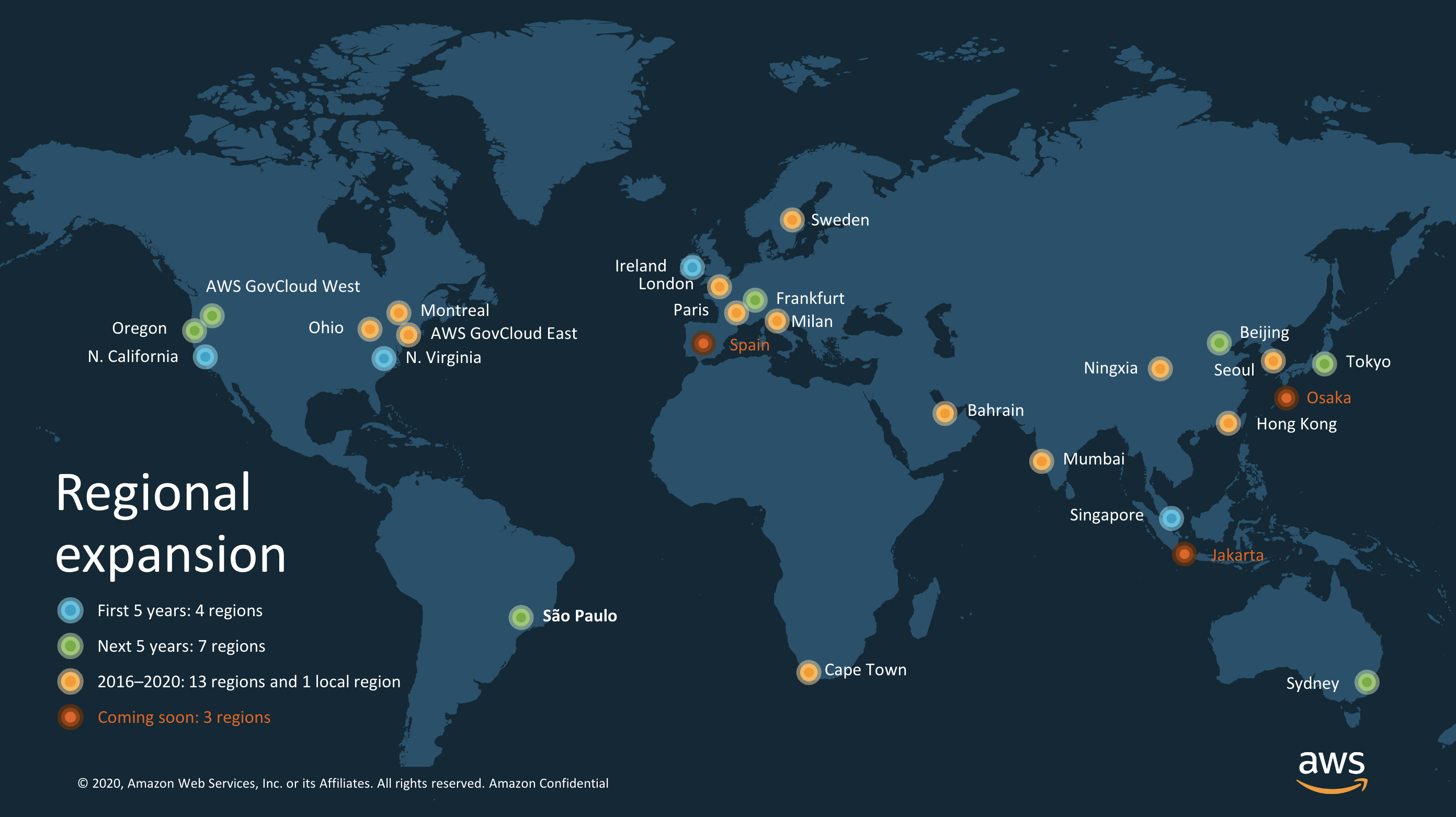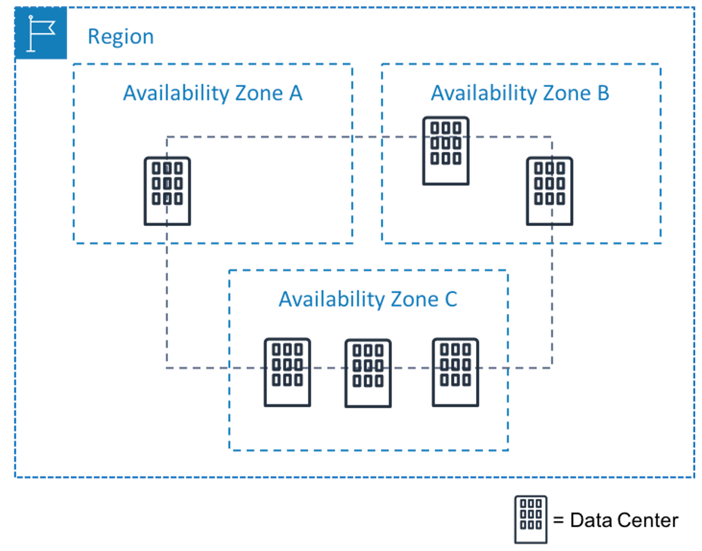Discovering the AWS World: Regions, Zones, and Beyond!
AWS Infrastructure: A Breakdown
Regions
A region is defined as an independent geographical area containing distinct physical data centers. On average, each region is comprised of three Availability Zones. Regions offer various AWS services, such as computing, storage, databases, networking, and other services.
Purpose: The aim is to allow users to deploy resources in proximity to their desired audience or specific geographic locations, guaranteeing quick access with minimal latency and adherence to data residency regulations.

What it contains?
The region contains multiple Availability Zones (AZs) that are physically separated data centres.
What is the need of regions?
Multiple regions ensure redundancy, disaster recovery, and compliance with data residency requirements. It minimizes the impact of outages in one region on another.
Important points
As of March 2024, there are 33 launched AWS regions worldwide.
Choosing the right region depends on factors like latency, data residency, and regulatory requirements.
Connection: Connected to other regions via high-bandwidth backbones (network) for data transfer between regions.
Availability Zones (AZs)
Each geographical region is subdivided into numerous Availability Zones (AZs), which are isolated data centres within the same region. These AZs are strategically separated from one another to ensure that any failures or disruptions in one zone do not impact the operations of other zones.

Purpose: Availability Zones (AZs) enhance the reliability and accessibility of AWS services by enabling users to distribute applications across numerous segregated regions.
What it contains?
Every availability zone (AZ) is equipped with a comprehensive array of hardware, software, and networking infrastructure necessary for the operation of various AWS services.
What is the need for zones?
Availability zones (AZs) offer redundancy within a designated region, thereby ensuring fault tolerance. In the event of a failure in one AZ, the resources in other AZs will remain operational.
Important points
The number of AZs varies per region, with an average of 3 AZs.
The number of AZs varies by region, typically ranging from 2 to 6.
Each AZ has its infrastructure and resources, including power, cooling, and networking.
Connection: Connected within a region through high-throughput, low-latency connections for data transfer between AZs.
Similarity and Differences between AZ and Regions
Similarities:
Both contribute to fault tolerance and high availability. They are interconnected within a region and provide redundancy and isolation to ensure the reliability of AWS services.
Differences:
Availability Zones (AZs) represent individual, isolated data centres within a region, each with its independent infrastructure. On the other hand, Regions encompass broader geographic areas where AWS has data centers, comprising multiple AZs. While AZs provide fault tolerance and high availability within a region, Regions offer geographic redundancy and compliance with data residency requirements.
Points of Presence (PoPs)
Geographically distributed infrastructure points around the world help to bring AWS services closer to end-users. Points of Presence (PoPs) do not offer a full range of AWS services but instead focus on hosting specific services like CloudFront, Route 53, and Global Accelerator.

Purpose: Improves performance by caching content closer to end-users.
What it contains?
PoPs contain networking equipment and caching servers to optimize content delivery and reduce latency.
What is the need for PoPs?
Content delivery networks (CDNs) decrease latency through the use of Points of Presence (PoPs), which store content and services in proximity to end users, thereby enhancing the quality of the user experience.
Important points:
There are currently over 600 PoPs spread across the globe.
PoPs connect to the nearest regional edge locations or to regional backbones.
Supports content delivery through the AWS CloudFront CDN.
Enhances the performance of web applications and content delivery.
Connection: PoPs connect to regional edge locations or directly to regional backbones for data transfer.
Edge Locations
These PoPs are specifically designed and strategically positioned in prominent urban centers or metropolitan regions. Essentially, they serve as the termination points for Amazon Web Services' content delivery network (CDN) service, known as Amazon CloudFront.

- Purpose: They host specific services like CloudFront caches and AWS Lambda@Edge functions to further reduce latency and improve performance for latency-sensitive applications.
What is the need for Edge Locations?
Edge locations provide an enhanced level of low latency in comparison to conventional Points of Presence (PoPs), rendering them exceptionally suitable for applications that necessitate instantaneous or nearly instantaneous interactions.
Important points:
Edge locations are a subset of PoPs, currently consisting of over 400+ locations.
Connection: They connect directly to the nearest regional backbones or other edge locations.
Local Zones
These AWS infrastructure deployments are specifically designed for major metropolitan areas, providing a localized presence. By bringing essential AWS services such as EC2 and EBS closer to end-users, these deployments offer specific applications the advantage of ultra-low latency.

What is the need for Local Zones?
Local Zones cater to workloads requiring extremely low latency, such as high-frequency trading, virtual reality, and real-time gaming.
Important points:
Local zones are a relatively new offering, with limited availability in select locations.
Local zones are smaller in scale compared to full regions.
They offer select AWS services, such as EC2 instances and EBS volumes, in proximity to specific locations.
They are designed to support workloads that require single-digit millisecond latency for end-users.
Connection: They connect to the parent region through a dedicated, high-bandwidth private network.
Key Differences:
Regions: The largest geographical unit, containing multiple AZs and offering a full range of AWS services.
AZs: Subdivisions within a region, providing redundancy and fault tolerance within a region.
PoPs: Distributed infrastructure points offering specific services closer to users, reducing latency.
Edge Locations: A subset of PoPs located in strategic locations, offering even lower latency for specific services.
Local Zones: Specialized deployments within metro areas, providing ultra-low latency for select services.
Connectivity Summary:
Regions: Connected via high-bandwidth backbones.
AZs: Connected within a region through high-throughput, low-latency connections.
PoPs: Connected to regional edge locations or directly to regional